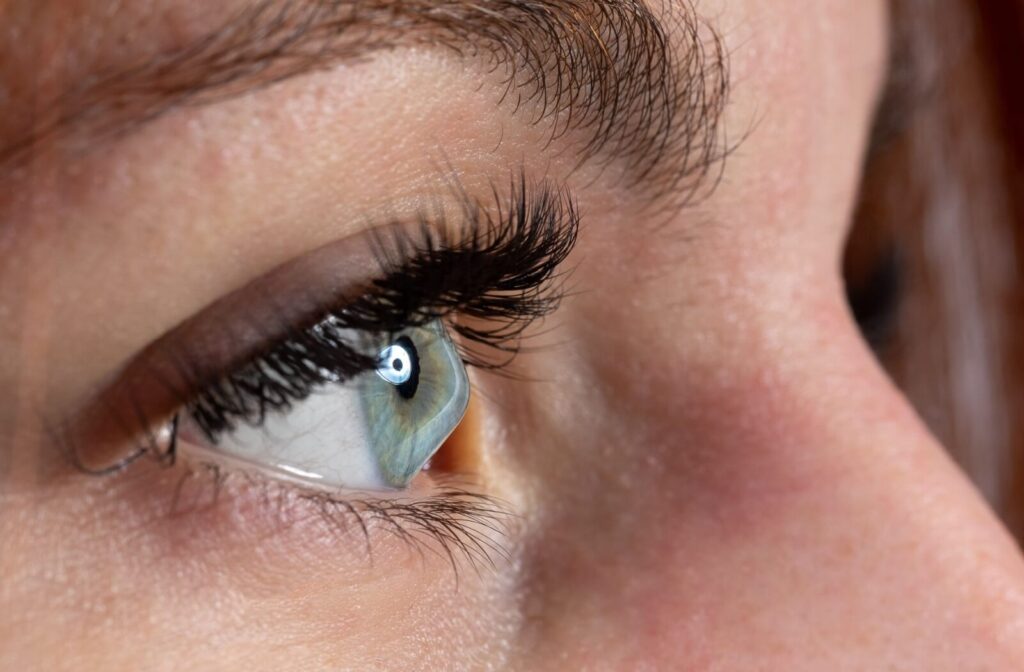Astigmatism is a unique eye condition that impacts vision clarity at various distances, making everyday visual tasks challenging. Unlike nearsightedness and farsightedness, which cause blurriness at specific ranges, astigmatism can impair vision overall.
Astigmatism can change or worsen over a person’s lifetime due to several factors, including age, eye injuries, or conditions like keratoconus.
However, it’s not all bad news. Astigmatism is typically an easily managed refractive error, generally addressed with corrective lenses—eyeglasses or contact lenses.
For adults with generally stable vision, laser eye surgery can help you reduce or eliminate the need for corrective eyewear altogether.
What Is Astigmatism?
Astigmatism occurs when either the cornea or lens is not perfectly round. The irregular shape affects how light travels to the retina, leading to blurred vision.
Untreated astigmatism can cause eye strain and headaches as the eyes work harder to focus.
Although refractive errors are typically diagnosed during childhood, astigmatism can develop at any age from various factors, including a family history of the condition, keratoconus, or eye surgeries.
How to Tell If You Have Astigmatism
Astigmatism is typically detected during a comprehensive eye exam, where your optometrist evaluates your visual acuity by asking you to read a standardized eye chart. Blurriness or difficulty seeing letters from a distance can be an initial indicator.
Other diagnostic tests, including keratometry and corneal topography, can provide more precise measurements of your cornea’s shape to help confirm if astigmatism is present.
If you’re experiencing any astigmatism symptoms, scheduling an eye exam with an optometrist is essential. These symptoms may include:
- Distorted or blurry vision
- Eye strain or fatigue
- Headaches
- Halos or distortion in your vision
It is especially crucial to seek medical attention if these symptoms interfere with your daily activities and impact your overall quality of life.
Can Astigmatism Change?

Eye conditions can change over time, especially as your eyes grow during childhood or undergo natural aging in later years. Astigmatism is not always a stable refractive error—its severity can change over time and may also decrease.
Regular eye exams are crucial for monitoring these changes and adjusting correction options accordingly.
Aging
As we get older, various aspects of our health change, including our eyesight. The natural aging process can alter the cornea’s shape over time, particularly in individuals with myopia (nearsightedness) alongside astigmatism.
These changes may result from changes in eyelid tension and eye muscles, affecting how light refracts through the eye and potentially worsening astigmatism.
Eye Injuries
Our eyes are incredibly intricate and delicate organs. Various eye injuries, such as those from foreign objects, chemical exposure, blunt force, or complications from surgery, can lead to changes in the cornea or lens. When the cornea heals irregularly from a scratch, or the lens suffers damage, it can lead to uneven light refraction and alter the degree of astigmatism.
Keratoconus
Keratoconus is a vision disorder that causes the cornea to thin and form a cone shape, significantly distorting light and exacerbating astigmatism. While keratoconus is uncommon, it can impact astigmatism when it occurs.
The condition is believed to have genetic links. It may also relate to factors such as eye allergies, excessive eye rubbing, and connective tissue disorders.
Treatment for Astigmatism
Modern treatments for astigmatism focus on addressing the refractive error to enhance visual clarity and improve the overall quality of life. Each treatment option is carefully tailored to your unique eye anatomy and lifestyle needs, ensuring optimal results with minimal disruption.
Talking with your eye doctor is the first step in determining an effective treatment path for your astigmatism. Here’s a deeper look into some correction options.
Eyeglasses
Eyeglasses remain a primary treatment for astigmatism, especially effective for mild to moderate cases. These corrective lenses are crafted to adjust how light enters your eyes, providing clear and precise vision.
With a wide range of frames to choose from, glasses can be both functional and fashionable.
Contact Lenses
Contact lenses offer a versatile solution for people who prefer an alternative to glasses. However, depending on the severity of your astigmatism, you may be unable to wear standard contact lenses.
Alternative lens designs, such as rigid gas-permeable (RGP), aspheric, and toric lenses, offer improved vision correction for people with astigmatism. These modern lenses can form a stable refractive surface that compensates for astigmatism, delivering reliable visual clarity.
Laser Eye Surgery
Laser eye surgeries, like LASIK and PRK, are attractive for those exploring convenient, lens-free solutions. These procedures reshape the cornea, effectively addressing astigmatism and potentially eliminating the need for corrective lenses entirely.
Eligibility for these surgeries is determined through a thorough eye examination that evaluates eye health and recommends a suitable surgery type to support positive outcomes.
Laser eye surgery may be an option that can correct multiple refractive errors if you have them. Therefore, discuss the possibility of laser eye surgery with your eye doctor.
Your Path to Clearer Vision Awaits
Navigating changes in your visual health can be challenging, but with proper care, astigmatism is manageable.
The Eye Care Team is dedicated to providing comprehensive eye exams, clearly explaining everything, and creating personalized treatment plans to meet your unique needs. Book an appointment today, and let’s work together to keep your vision clear and your eyes healthy.



